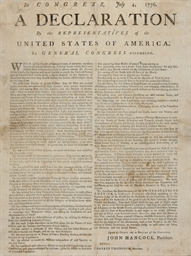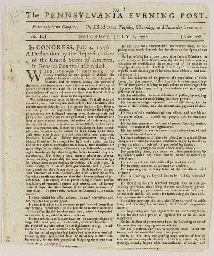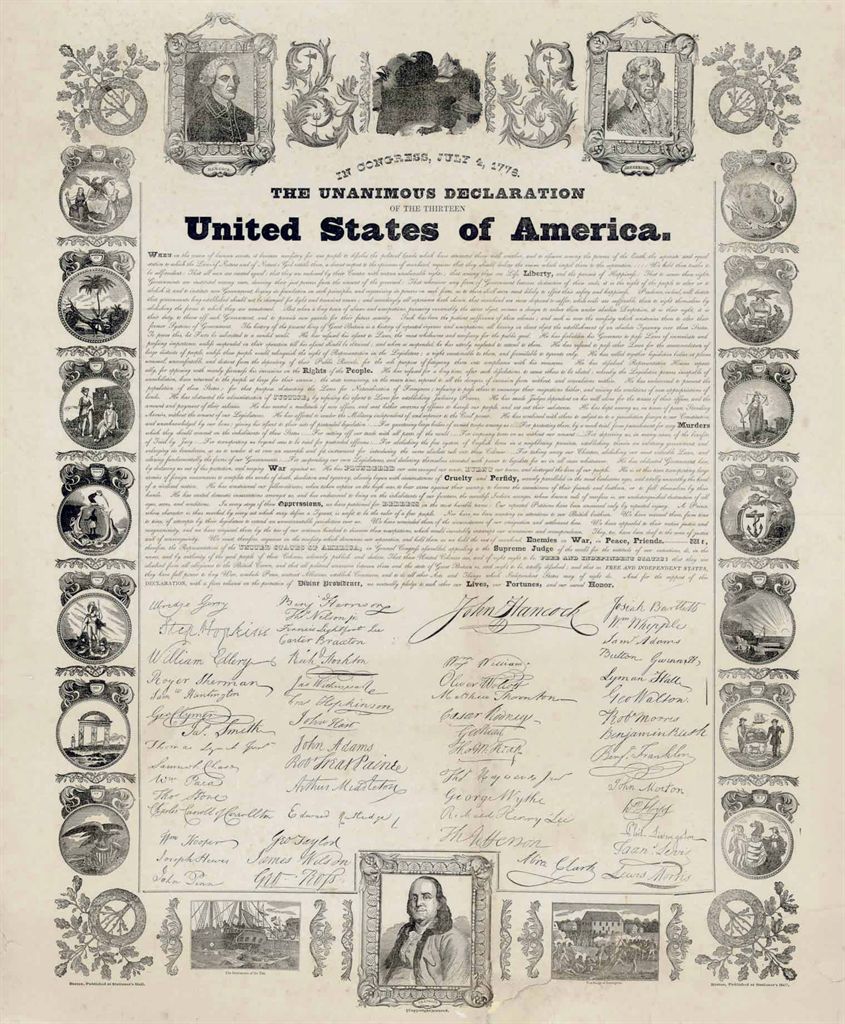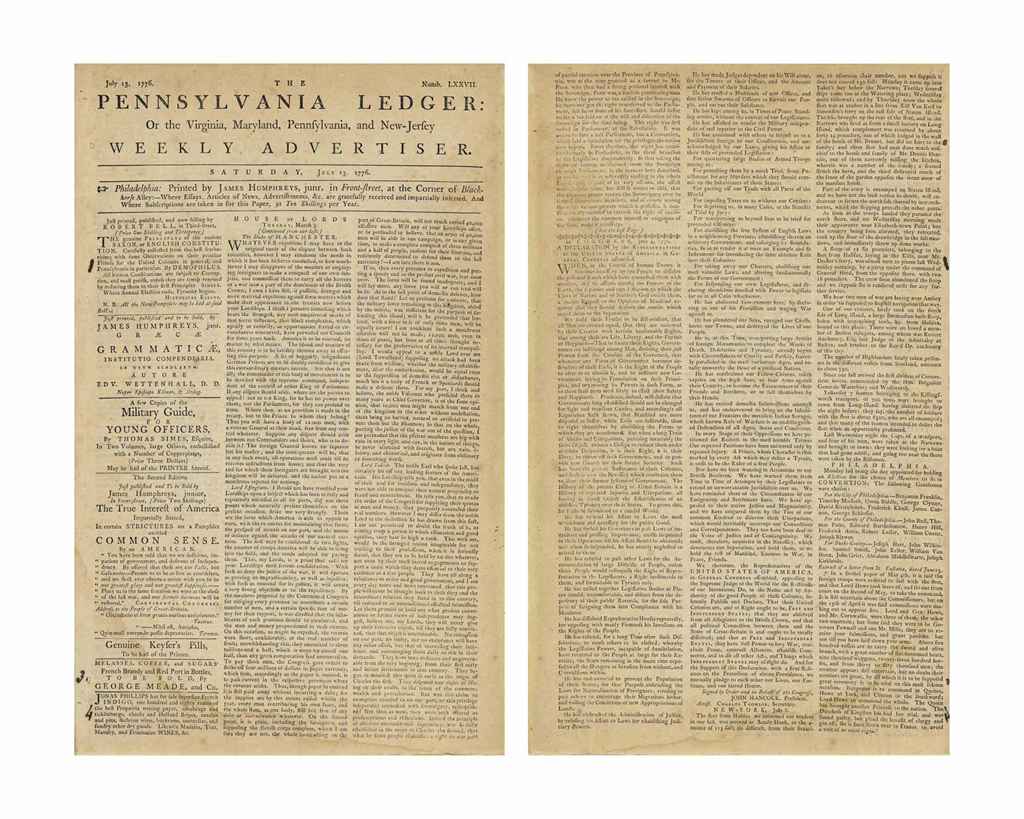DECLARATION OF INDEPENDENCE]. Boston Gazette and Country Journal, containing the freshest Advices, Foreign and Domestic, No. 1105 [Col.1:] In Congress, July 4, 1776. A Declaration...When in the Course of human Events.... Watertown, Massachusetts: Benjamin Edes, Monday, 22 July 1776. Folio, 4pp. ( 14¾ x 9 3/8 in.). Large woodcut masthead ENGRAVED BY PAUL REVERE (Brigham, p.199: 2¼ x 8¼ in.: seated personification of liberty with cap on pike, a bird flying from a birdcage, stylized scene of Boston), text printed in roman and italic types in three columns. The masthead woodcut worn (or poorly inked), unobstrusive repairs to central fold, OTHERWISE IN EXCELLENT ORIGINAL CONDITION. The Declaration occupies cols.1 to 3. THE DECLARATION OF INDEPENDENCE, PRINTED BY A BOSTON PATRIOT PRINTER, WITH MASTHEAD BY PAUL REVERE The first Watertown printing of the historic text, still being disseminated throughout the colonies in the wake of the Continental Congress's vote in Philadelphia. Edes is believed to have received the text on July 18 (Thursday) or 19 (Friday), so his issue of the 22nd is the first of this weekly which could carry the momentous news. The paper also contains news regarding the Continental Congress, the American army, the destruction of the equestrian statue of George III in New York, and a detailed account of the ceremony in which the Declaration of Independence was proclaimed at the Boston State House, 18 July: "At One o'clock the Declaration was proclaimed...after it was read and greeted with "three huzzas," thirteen pieces of cannon were fired," a toast was offered "to the United States of America, the American Congress...& to General Washington," then "the bells of the town were rung." Benjamin Edes (1732-1803), publisher of the weekly Boston Gazette and Country Journal is himself a figure of considerable interest, both as printer and as patriot. A fellow Bostonian, printer Isaiah Thomas, later wrote, "No publisher of a newspaper felt a greater interest in the establishment of the Independence of the United States than Benjamin Edes; and no newspaper was more instrumental in bringing forward this important event than The Boston Gazette (Thomas, History of Printing in America , ed. M.McCorison, p.137). The Boston Gazette and Country Journal was launched in 1755 by Edes and a partner, John Gill and rapidly became the main organ of the Boston Whigs and Sons of Liberty, those at the forefront of organized opposition to British rule. As Thomas records, the paper was "distinguished for the spirited political essays," it printed (Thomas, p.134). During the Stamp Act agitation Governor Bernard, stung by the paper's unrelenting political invective, termed it "the most facetious paper in America" (J.E. Triber, A True Republican , p.48). Sam Adams, Joseph Warren and James Otis frequently contributed to the paper, and the shop became a meeting place for political activists. Paul Revere a lodge brother of Edes at the St. Andrews Lodge, cut the fine woodcut masthead for the paper, first used in 1770 (see Brigham, Paul Revere's Engravings , p.199). In 1770, the Gazette used woodcuts by Revere for the coffins of the victims of the Boston Massacre (Brigham, pl.69) and advertised Revere's famous incendiary print of that incident, "The Bloody Massacre." In 1775, as organized resistance to British occupation forces spread, Gill retired, and the paper's publication was suspended on April 17, just two days before the Lexington and Concord alarms. Afterwards, as the British army barricaded the city, Edes, fearing arrest, made a dramatic escape by boat, carrying a press and some trays of lead type. He set up temporary shop in Watertown, some 30 miles from Boston, resumed publication of the Gazette and became printer to the provincial congress of Massachusetts, also meeting in Watertown. During Edes's exile (which lasted until November 4, 1776) essential supplies were dificult to obtain. Thomas notes the severe shortage of paper, "wr
DECLARATION OF INDEPENDENCE]. Boston Gazette and Country Journal, containing the freshest Advices, Foreign and Domestic, No. 1105 [Col.1:] In Congress, July 4, 1776. A Declaration...When in the Course of human Events.... Watertown, Massachusetts: Benjamin Edes, Monday, 22 July 1776. Folio, 4pp. ( 14¾ x 9 3/8 in.). Large woodcut masthead ENGRAVED BY PAUL REVERE (Brigham, p.199: 2¼ x 8¼ in.: seated personification of liberty with cap on pike, a bird flying from a birdcage, stylized scene of Boston), text printed in roman and italic types in three columns. The masthead woodcut worn (or poorly inked), unobstrusive repairs to central fold, OTHERWISE IN EXCELLENT ORIGINAL CONDITION. The Declaration occupies cols.1 to 3. THE DECLARATION OF INDEPENDENCE, PRINTED BY A BOSTON PATRIOT PRINTER, WITH MASTHEAD BY PAUL REVERE The first Watertown printing of the historic text, still being disseminated throughout the colonies in the wake of the Continental Congress's vote in Philadelphia. Edes is believed to have received the text on July 18 (Thursday) or 19 (Friday), so his issue of the 22nd is the first of this weekly which could carry the momentous news. The paper also contains news regarding the Continental Congress, the American army, the destruction of the equestrian statue of George III in New York, and a detailed account of the ceremony in which the Declaration of Independence was proclaimed at the Boston State House, 18 July: "At One o'clock the Declaration was proclaimed...after it was read and greeted with "three huzzas," thirteen pieces of cannon were fired," a toast was offered "to the United States of America, the American Congress...& to General Washington," then "the bells of the town were rung." Benjamin Edes (1732-1803), publisher of the weekly Boston Gazette and Country Journal is himself a figure of considerable interest, both as printer and as patriot. A fellow Bostonian, printer Isaiah Thomas, later wrote, "No publisher of a newspaper felt a greater interest in the establishment of the Independence of the United States than Benjamin Edes; and no newspaper was more instrumental in bringing forward this important event than The Boston Gazette (Thomas, History of Printing in America , ed. M.McCorison, p.137). The Boston Gazette and Country Journal was launched in 1755 by Edes and a partner, John Gill and rapidly became the main organ of the Boston Whigs and Sons of Liberty, those at the forefront of organized opposition to British rule. As Thomas records, the paper was "distinguished for the spirited political essays," it printed (Thomas, p.134). During the Stamp Act agitation Governor Bernard, stung by the paper's unrelenting political invective, termed it "the most facetious paper in America" (J.E. Triber, A True Republican , p.48). Sam Adams, Joseph Warren and James Otis frequently contributed to the paper, and the shop became a meeting place for political activists. Paul Revere a lodge brother of Edes at the St. Andrews Lodge, cut the fine woodcut masthead for the paper, first used in 1770 (see Brigham, Paul Revere's Engravings , p.199). In 1770, the Gazette used woodcuts by Revere for the coffins of the victims of the Boston Massacre (Brigham, pl.69) and advertised Revere's famous incendiary print of that incident, "The Bloody Massacre." In 1775, as organized resistance to British occupation forces spread, Gill retired, and the paper's publication was suspended on April 17, just two days before the Lexington and Concord alarms. Afterwards, as the British army barricaded the city, Edes, fearing arrest, made a dramatic escape by boat, carrying a press and some trays of lead type. He set up temporary shop in Watertown, some 30 miles from Boston, resumed publication of the Gazette and became printer to the provincial congress of Massachusetts, also meeting in Watertown. During Edes's exile (which lasted until November 4, 1776) essential supplies were dificult to obtain. Thomas notes the severe shortage of paper, "wr




.jpg)
.jpg)




.jpg)
.jpg)



Try LotSearch and its premium features for 7 days - without any costs!
Be notified automatically about new items in upcoming auctions.
Create an alert